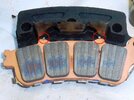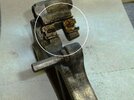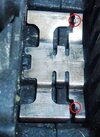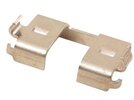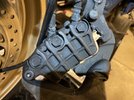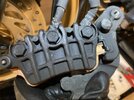While slight scraping is normal - particularly if the discs have some slight surface rust on them (typical putting in the garage after a wet ride) - they should not be causing any significant resistance to the turning of the wheel.
70-80 degrees Centigrade is too hot to touch. That is way too hot, but not as hot as they might be if there was a serious build up of pressure. The pads are releasing, so although it remains a possibility, my own preference is to check out the mechanics before looking into the hydraulics. The mechanism has to work properly anyway.
The rear disc is usually warmer than the front. The exhaust pipe and lack of cold air flow sees to that. But after riding 10km without touching the brakes, then you would expect them to feel cool or cold.
The plumbing on the ST1100 ABS with combined braking system is almost identical to that of the ST1300.The brakes each have 3 piston calipers. The pad springs are a similar design.
The front lever operates the two outer pistons of the front caliper.
The rear brake pedal operates the centre piston of all three calipers front and rear.
When moving and the front brake is applied by operating the lever or the pedal, then the SMC (on the front left fork leg) operates the outer two pistons on the rear caliper. It does this by the action of the front caliper moving upwards and forwards slightly and a linkage pushing up on the SMC plunger.
In the garage, when the bike is stationary, the brake pedal will also allow fluid to pass through the SMC to the rear outer pistons, without the SMC plunger being operated.
It sounds as though your SMC is releasing the brakes, but the pads or calipers are not moving properly. This may be a oroblem with the SMC, but I would look at the caliper movements first of all.
Much of what you will read in my article on the 'pitfalls' in the ST1300 system will also apply to the 1100.
This can be found here. And some key differences are mentioned below this link.
A close hands-on look at the Honda ST1300 braking system. These are personal observations about the things that can go wrong, why they go wrong and what can be done to keep things working sweetly. Updated April 2020 and to address more recent observations, to include information about the SMC...

www.st-owners.com
Download the pdf file attached to post#1.
Key differences between the article for the ST1300 and your 1996 ST1100.
1) On the ST1100 that has ABS II and CBS, the SMC is behind the the left fork leg, mounted vertically (ish) behind the plastic shroud. It is not integrated into the caliper bracket like the ST1300, nor does it need to be tilted when bleeding.
The linkage to operate the SMC is a 3-holed casting looking like the ace of clubs. Two of the holes contain needle roller bearings. This casting is sandwiched between two metal plates. One hole links to the fork leg, another to the SMC plunger and the third to the brake caliper bracket. This linkage needs to be able to move freely. Because it is hidden behind the shroud it can be overlooked and become dry and rusted or filled with road crud. It stops the SMC from working properly.
I have a diagram of this assembly somewhere, I'll post it when I find it. Found it, and I've coloured it in. I like colouring in.

The green item is the 3 hole casting - 2 needle roller bearings. The right hand side (rear) plate has two captive nuts into which the bolts screw. If you take intend to clean it up, take a photo before you take it apart. It isn't immediately obvious how it goes back together.
2) The ST1300 has a bleed valve up on the right hand side near to the proportional control valve. Roughly where your right knee is when riding. The ST1100 doesn't have this bleed valve.
Pads not releasing may be due to the calipers not sliding properly on their mounts, or by corroded pad pins. What can happen is that the pistons release the pressure on the outer brake pad, but the caliper cannot slide in order to allow the inner pad to move away from the disc surface.
Thus is how they are supposed to move:
An animation of the action of the brake caliper of a Honda ST1100 and ST1300. It is obvious that the pistons move out to the right to press the outer pads against the brake disc/rotor. It is not obvious, unless you have thought about it, that the entire caliper must be free to move to the...

www.st-owners.com
If you have some drag on the front pads, that will cause a drag on the rear. The rear pads have white heat shields on the back of the pads. The front ones do not. If you try to put heat shields in the front (say salvaged from old rear pads), the front pads will drag until they have worn down a fair bit. Which will cause drag on the rear caliper.
Check that the correct pads are fitted front and rear (read the article) On the 1100ABS, the front and rear pads are the same size, but the differences mean that if they are inserted incorrectly, one or more of them will drag.
This and everything else in that document applies to the ST1100 - brake caliper movement, pad pins, pad retainer clips, lubrication, action of pistons, testing procedure.
It is also worth checking the installation of the front wheel. If the axle has not been inserted and secured in the proper sequence, then this can cause the left hand caliper to be slightly misplaced, which could cause the front brake to drag a little, which will operate the SMC, which will cause the rear brake to drag.
That is a quick run down of what to look for. Sorry it isn't written specifically for the 1100, but much of it still applies. I parted company with my 2000ABS model in 2008 and I haven't worked on one since. So speak up if you don't understand something - someone with an 1100 and/or a better memory will be able to put you right.
But read that article. I guarantee that there will be stuff in there that you didn't know.




